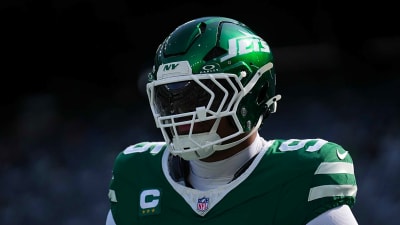Josh Allen's failed fourth down calls into question the use of tracking technology in the NFL
The Buffalo Bills are once again left questioning how they came up short against the Kansas City Chiefs in the playoffs, both on the scoreboard and on the field.
Early in the fourth quarter of the AFC Championship game, Bills quarterback Josh Allen attempted to convert a 4th-and-1 at the Chiefs 41-yard line. The Kansas City defense did just enough to stop Allen, at least, according to one referee.
The Chiefs' defense stops them on fourth down!
— NFL (@NFL) January 27, 2025
: #BUFvsKC on CBS
: Stream on @NFLPlus and Paramount+ pic.twitter.com/VwGmEZ3IrW
The down judge and line judge disagreed on the spot, with the line judge running in and saying Allen got it while the down judge marked him short. The crew let the down judge spot the ball just inches shy of the first down.
Upon further review, the ruling on the field stood, but not without some controversy. CBS analyst Gene Steratore disagreed with the officials, saying he thought Allen gained the first down by a third of the football.
In the end, it was a turnover on downs, and the Chiefs went on to score the go-ahead touchdown and win the game, 32-29.
Among those unconvinced of the spot was Bills general manager Brandon Beane.
"I feel like he got that," Beane said in an end-of-season news conference. "I still feel like he got that. I felt that in the moment, and nothing has changed my mind on that."
Beane explained that NFL officials discussed the referee's decision-making with him, and while he doesn't agree with their conclusions, he expressed that they're also ultimately plays the Bills didn't make.
However, it's hard to see the back and forth on this call ever stopping because everyone is relying on their own eyes.
But in a game with a conference title on the line, should we be letting these calls come down to human error?
Yes, there's replay assist, but in a situation where there's a mass of bodies covering Allen, it's hard for everyone to definitively say the ball got far enough before he was stopped. This has raised the prospect of integrating even more technology into the game.
The NFL has been testing several technologies to aid in making these close calls. For instance, they are looking at optical tracking technology to replace the first-down chains. This would take the decision of the spot out of the hands of officials; however, it's not ready for primetime.
According to Yahoo! Sports senior reporter Henry Bushnell, Hawk Eye, the name of the optical tracking system, would require an unobstructed view of the ball. In Allen's case, he was quite obstructed by the Chiefs defense. Further, the spot of the ball is also determined before a player's body part touches the ground or the officials rule the play dead, meaning any tracking system is going to have to track every part of the runner's body.
Still, RFID tracking technology has been a part of the game since 2017. The source for Next Gen Stats comes from microchips inserted into the ball, pylons, sticks, officials' uniforms and players' shoulder pads. They weren't designed with helping referees in mind, but the NFL has been looking into how the chips could be used to locate the ball, according to Bushnell.
With such a high-profile moment showcasing the limitations of human judgment, the pressure is on to test this technology, despite its margin of error of up to six inches. The league will need to weigh the risks of incorporating new technology with the current outcry over close calls that swing the momentum of the game when everything is on the line.
More must-reads:
- Three wide receiver options the Bills should consider this offseason
- 25 NFL legends who never won a Super Bowl ring
- The 'Active NFL 4th quarter comebacks leaders' quiz
Breaking News
Trending News
Customize Your Newsletter
 +
+
Get the latest news and rumors, customized to your favorite sports and teams. Emailed daily. Always free!








